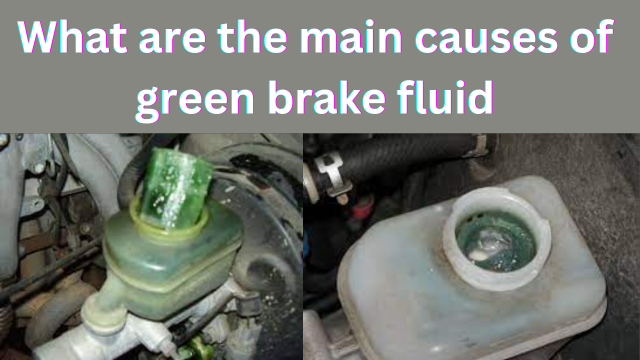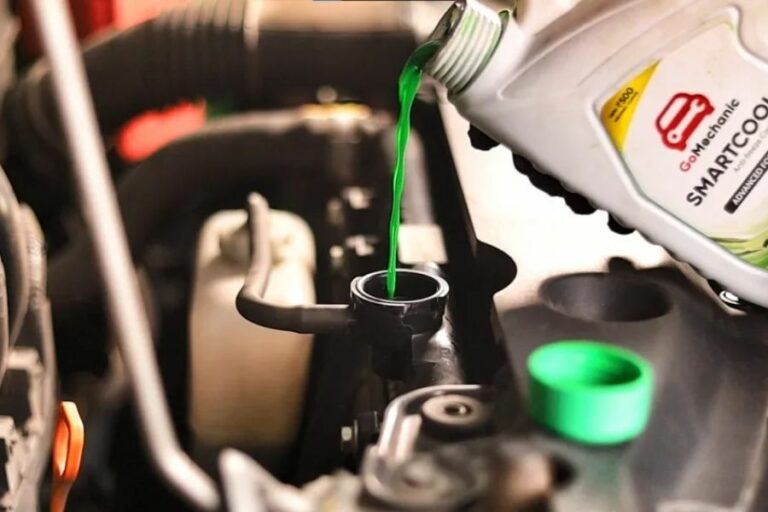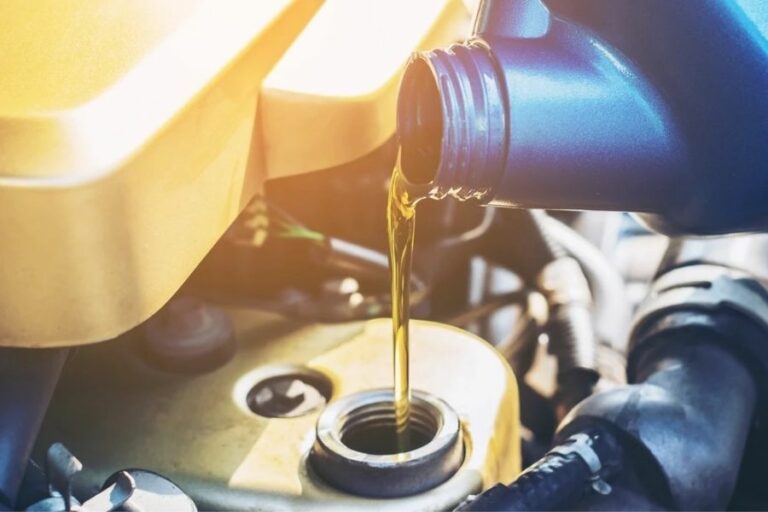Why is my Brake Fluid Green? Know main Causes
Many cases were reported in real life where road accidents occurred because of the issues in the brake system of the vehicle and resulted in dreadful outcomes. So, one must remain careful about the functioning of brakes and their regular maintenance. This means you need to understand the signs that are an indication of brake-related issues.
Why is my brake fluid green? The brake fluid can turn green by the addition of the metal particles of the brake lines or wheel cylinders in the brake fluid. This happens when pressure is applied on the brake pedal to reduce the speed of the vehicle. Furthermore, in the case of leakage in the brake system, the oxygen contamination can turn this fluid green.
Here, we will discuss the role of brake fluid in the effective functioning of the brake mechanism, the reasons behind the green fluid, and how to deal with this situation. So, stay with us.
You may also read Brake Fluid Leaking Under Middle of Car
Why is my Brake Fluid Green : Main Causes

The brake fluid is usually yellow. But in some cases, it turns green because of water or oxygen contamination. Green brake fluid means that the acidity level in the braking system is high. This acidity can destroy the grip or control of the brakes by destroying the brake seals if you don’t fix the cause or change the fluid. So, one must understand the reasons that turn the fluid green. Let’s check them one by one:
Leakage
The leakage can also be indicated by the green color of the field because of the interaction with air or moisture. So, this thing makes it acidic in nature, making it harmful to the brake system.
People also read: Yellow Fluid Leaking from Car
Over Usage
You need to change your brake fluid from time to time, depending on the guidelines and the usage. But in the case of using old fluid for a long time, overuse will result in breaking its components. The old fluid will further cause reactions by interacting with the brake parts, increasing the fluid’s copper level.
More Water Absorption
Brake fluid has the tendency to absorb moisture from the surroundings, so this thing results in a higher percentage of water in the fluid. This thing will increase the boiling point of the fluid and can cause overheating problems. The overheating can turn the fluid green.
Metal Contamination
As the brake system is composed of different metals, when we apply pressure on the brake pedal, some metal particles from the brake lines, calipers, and wheel cylinders become part of the brake fluid. This contamination results in changing the color of the fluid over time, and in most cases, it turns into dark green.
Oxygen Contamination
The green color may occur in case the brake fluid interacts with the oxygen, and that changes this chemical substance to acidic in nature. Due to the copper material in the brakes, the acidic fluid causes chemical reactions, due to which it turns into a greenish color from yellowish. This oxidation is also harmful in terms of creating corrosion of other components of the brake system that contain other metals. This process eventually reduces the power of the brake pads by providing a slow response.
Why Does Every Vehicle Have Brake Fluid?
Just like brake pads are a must part of any vehicle brake system, brake fluid is also one of the crucial things that play its role in providing complete control over the speed while driving. But how does it perform its role in stopping a vehicle? Providing enough hydraulic pressure to the brake allows the brake pads to contract to slow down the speed.
In case of a low level of brake fluid due to leakage, enough hydraulic pressure cannot be achieved. This means the brake disc will not work effectively in stopping the vehicle, which can result in accidents. Not just accidents, lower fluid levels can result in corrosion among the parts of the brake system because of the absorption of moisture from the air.
The presence of moisture on brake lines makes them ineffective and have adverse effects on different parts. Remember that if you ignore the green brake fluid, then this will cause you to spend more on repairing the worn-out parts caused by this acidic fluid.
Proper Way to Check Brake Fluid
You don’t need a mechanic to check the brake fluid color, as you can do by yourself. All you have to do is park your vehicle at a smooth level without any slope and turn off the engine to evaluate the brakes.
Make sure to keep with yourself an effective engine degreaser to clean the brakes properly and a funnel. Now perform the following steps to examine the brake fluid:
- Go to the brake master cylinder, which is located close to the firewall, by opening the hood of the vehicle. It is usually available in the engine portion on the driver’s side.
- You can check the level of the fluid with the help of minimum and maximum fill lines. If the level is at or near the maximum line, then this means there is no leakage.
- In case the level of fluid is below the maximum line or in between the maximum and minimum line, then you need to add more fluid.
- Remember to choose only the type of brake fluid that is mentioned in the guidelines provided by the manufacturer.
- See the color of the fluid. If it is green, then it is time to get the vehicle checked by an expert mechanic or technician to rule out the causes and to fix any technical fault without facing further damage.
- The technician will tell you whether you need to change the brake parts or just refill or flush the old fluid enough by checking the condition of your braking system.
- Bleeding the brake fluid requires no specific technique, and you can do so by yourself. You need to drain out all the contaminated fuel to refill new fluid into it. Remember to drain out the fluid from the reservoir first, as 20 percent of the brake fluid is there, which can cause contamination of the new fluid as well.
FAQs about why is my brake fluid green:
Q: What is the purpose of brake fluid?
Brake fluid is a chemical liquid that is a must part of the hydraulic braking system of various automobiles like passenger cars, trucks, or even bicycles. It plays its role in making the brake pads effective in stopping or slowing down the vehicle. When the brake pedal is pressed by the foot, then this fluid transfers the pressure towards the brake pads. So, these brake pads are pressed against the rotor, and with just a little force, you are able to maintain the speed with just this chemical fluid.
Q: What is the right time duration to change the brake fluid?
There is no hard and fast rule regarding the duration that one must follow before changing the brake fluid. However, people usually change it within 1 or 2 years. The need for this change totally depends upon the mileage. The higher the number of kilometers your vehicle has covered, the sooner you need to change the brake fluid.
Q: Is brake fluid available in different types in the market?
Yes, brake fluid is available in the following types:
- DOT 3
- DOT 4
- DOT 5
- DOT 5.1, etc.
DOT 3, DOT 4, and DOT 5.1 are glycol-based fluids that are corrosive in nature, so they affect the paint of the surroundings. DOT 5 is a silicone-based fluid that is beneficial in terms of providing protection against rust and does not corrode the paint of the surroundings.
Q: Can I mix two different types of brake fluid?
No, it is not recommended as this thing will affect the brake’s functioning. Some fluids are preferable for only ABS brakes, while others are suitable for all. So, you need to use only the type of brake fluid that is recommended by the vehicle manufacturers. Furthermore, each type of fluid has its own characteristics like different boiling points, Corrosive or noncorrosive nature, etc.
Bottom Line
The safe driving experience of any vehicle entirely depends upon the effectiveness of the brake system. So, one must be careful in observing any sign of issue like the change of brake fluid or fluid leakage. After reading this article, now you are clear why is my brake fluid green.
By preventing all the possible reasons that can turn this fluid green, you don’t need to change it quite often. Furthermore, checking the color of this fluid also helps you get an idea about the technical issues that may result in serious outcomes if they remain unresolved. This strategy also saves you costs by changing the fluid on time before the worn out of different parts.





![What Happens If You Never Change Differential Fluids? [Revealed the Truth]](https://carfluidpro.com/wp-content/uploads/Never-Change-Differential-Fluid-–-What-Will-Happen-768x512.jpg)
